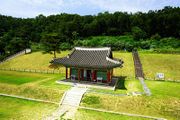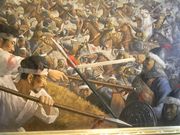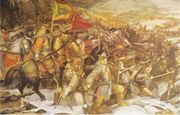"2018 GGHS Team 4"의 두 판 사이의 차이
(→Pictures Gallery) |
(→Team Information) |
||
| 19번째 줄: | 19번째 줄: | ||
=Team Information= | =Team Information= | ||
| + | Each student's page contains their essay and contribution to the research. | ||
[[파일:IMG 0059 (1).JPG]] | [[파일:IMG 0059 (1).JPG]] | ||
{| class="wikitable sortable" style="text-align:center; width:645px" | {| class="wikitable sortable" style="text-align:center; width:645px" | ||
2018년 7월 26일 (목) 21:17 판
목차
Topic

The Lives of Goryeo People during the Military Regime
Choe U (崔瑀; 1166 - 1249) was the second Choe dictator of the Ubong Choe military regime. He himself went out on the battlefield to lead in fighting off the Mongolian invasions. Then he realized that the government was no longer safe at the capital city of Kaesong, and so he forced the king Gojong (r. 1213-1259) and his officials to flee to Ganghwa island. He took some of his armies and went to Ganghwa island with them. He did this because he knew that the Mongols would not attempt a naval assault against Ganghwa. Therefore, the Goryeo government was kept safe for several decades even after the Choe regime.[2]

Since the transfer of power, the Choe administration has relied on the geographical advantages of Ganghwa Island rather than providing active resistance to the war. So they enjoyed the same luxury and stayed in office. This is why it is assessed that the transfer of the capital was only aimed at defending the military regime and guaranteeing the safety of some ruling groups, rather than focusing on tactical values or diplomatic strategy.[4]

The Choe administration had never fought against the Mongols in a grand dream struggle, and has only postponed its surrender on Ganghwa Island indefinitely. Rather, they brought various trees to Ganghwa Island, where they formed a wide circle of trees, built large houses, and enjoyed the scenery. Choe and the military rule did not care whether the people were captured and killed or stolen by the Mongol army.[6]
The tyranny of the military rule to take power made the country's politics difficult.The military rule illegally robbed the people's land and collected more taxes than they had set. Local governments raised taxes on the land to satisfy their greed, making life more difficult for the people.[7] The military needed more land and more grain to stay in power. People had to suffer and live a tough life. Uprisings took place frequently under the military regime.[8]
Goryeo was invaded seven times over 30 years by Mongols. The Choe administration continued to live a luxurious life in Ganghwa. On the other hand, people who were abandoned on land suffered all kinds of hardships and the land was devastated. According to Goryeosa Jeolyo, about 206,800 people were taken to Mongolia as prisoners during the fifth invasion and many lives were killed. Then the tax burden began. However, Goryeosa Jeolyo says the people waited for the Mongol army to come, as too much tax was collected.[9]
Team Information
Each student's page contains their essay and contribution to the research. 파일:IMG 0059 (1).JPG
| Team Position | Page Name | Name (Korean) | Student ID | Wiki ID |
|---|---|---|---|---|
| Teacher | Anca | 안카 | 4-Anca | |
| Leader | 박이소 | 박이소 | 2304 | 4-박이소 |
| Vice-Leader | 김해인 | 김해인 | 1208 | 4-김해인 |
| Member | 이다빈 | 이다빈 | 1318 | 4-이다빈 |
| Member | 홍연재 | 홍연재 | 1424 | 4-홍연재 |
| Member | 남연수 | 남연수 | 1607 | 4-남연수 |
| Member | 심재희 | 심재희 | 2307 | 4-심재희 |
| Member | 김하영 | 김하영 | 1105 | 4-김하영 |
Presentation Materials
(Please upload script, ppt etc.here)
홍연재 script
Have you ever heard of Lee Eui-bang, Jung Joong-bu and Lee Eui-min?
I'm going to present these people's psychology.
Their psychological transformation comes in the military rule and the inferiority complex they had before the military revolution turned them into superiority.
As their sense of superiority continues, they have an superiority complex.
A superiority complex is a state of acting like the best.
People in this state have the personality to ignore others and show off themselves.
As such, they take power based on the belief that they are superior, and they are forced and exploited.
Media
Pictures Gallery
First Day
- 20180725 171000.jpg
- 20180725 212518.jpg
- 20180725 162118.jpg
- 20180725 162503.jpg
- 20180725 212417.jpg
- 20180725 212421.jpg
- 20180725 212424.jpg
- 20180725 212428.jpg
- 20180725 212444.jpg
- 20180725 212449.jpg
- 20180725 212532.jpg
- 20180725 144625.jpg
- 20180725 144628.jpg
- 20180725 214155012.jpg
- 20180725 214303857.jpg
- 20180725 214510613.jpg
- 20180725 214514820.jpg
- 20180725 214534192.jpg
- 20180725 220840.jpg
Second Day
- 20180726 180337.jpg
- 20180726 180447.jpg
- 20180726 180449.jpg
- 20180726 181138.jpg
- 20180726 181153.jpg
- 20180726 181203.jpg
- 20180726 181230.jpg
- 20180726 183917.jpg
- 20180726 205028.jpg
- 1532598385003rtygfdd.jpg
- 20180726 162258.jpg
- 20180726 162306.jpg
- 20180726 180136.jpg
- 20180726 180139.jpg
- 20180726 180145.jpg
- 20180726 180152.jpg
Last Day
Videos
Terms Related to the Topic
- 무신정권 武臣政權 (Musin Jeonggwon): Goryeo military regime, Goryeo military rule[10]
- 武: martial; military; warlike
- 臣: minister; official; statesman; courtier; vassal
- 政: government; political; politics; political affairs
- 權: authority; power; right
- 문인 文人 (munin): literati[11]
- 文: literary; writing; culture; formal; language; article; literature
- 무인 武人 (muin): military[12]
- 武: martial; military; warlike
- It was originally translated as 'writers' and 'warriors' by student 박이소.
- 팔방상 八坊廂 (palbangsang): eight wards[13]
- 八: eight
- 坊: subdivision of a city; neighborhood; subdivision; urban subdivision
- 廂: box (in theater); side room; side-room; theatre box; wing; cabin
- 출배도감 出排都監 (Chulbae togam): Directorate General of Resettlement[14]
- 出: to go out
- 排: a platoon; line up; row of logs or boards; to rank; row; line; to place
- 都: all
- 監: to supervise; supervisor; prison; control; direct; to inspect
- 구제도감 救濟都監 (Gukje togam): Directorate General of ?
- 救: to rescue; to save; to assist; aid; help; relieve
- 濟:aid; to ferry; frugal; cross; economical; to help; relieve
Essays
김하영 uploaded at 11.45.
남연수 uploaded at 13:37.
Resources
Goryeo
Mongol Invasions of Korea
Goryeo military regime
Gojong of Goryeo (r. 1213 – 1259)
Choe U
Goryeogung Palace Site (고려궁지)
Goryeo Palace (Goryeogung)
References
- ↑ 강화 고려궁지
- ↑ Choe U
- ↑ Quora
- ↑ 우리역사넷/최우의 호화로운 강화 생활/『고려사절요』권16, 고종안효대왕 3 을사 32년 5월
- ↑ Korean History Info: The Mongol Invasions
- ↑ 나무위키/여몽전쟁
- ↑ zum학습백과/무신정변이후 백성들의 봉기
- ↑ 우리역사넷/정중부, 무신들의 세상을 만들다
- ↑ 高麗對蒙抗爭史硏究(A Study on the History of Mongol Resistance)/윤용혁
- ↑ 武臣政權-한국학 영문 용어·용례 사전
- ↑ 文人- 한국학 영문 용어·용례 사전
- ↑ 武人- 한국학 영문 용어·용례 사전
- ↑ Shultz EJ, Kang HHW. 2014. Koryosa choryo II: Essentials of Koryo History, Seoul: Jimoodang, pp. 314-5.
- ↑ Shultz EJ, Kang HHW. 2014. Koryosa choryo II: Essentials of Koryo History, Seoul: Jimoodang, pp. 314-5.
